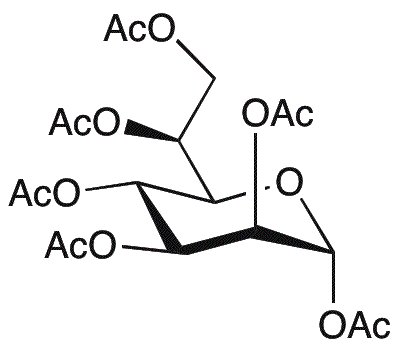L-glycero-a-D-manno-Heptopyranose 1,2,3,4,6,7-hexaacetate is widely utilized in research focused on:
- Pharmaceutical Development: This compound serves as a key intermediate in the synthesis of various pharmaceuticals, particularly in the development of glycosylated drugs that enhance bioavailability and efficacy.
- Biotechnology: It is used in the formulation of glycoproteins and other biomolecules, aiding in the creation of therapeutics that mimic natural biological processes.
- Food Industry: The compound can be employed as a food additive, providing functional benefits such as improved texture and stability in various food products.
- Cosmetics: Its properties make it suitable for use in cosmetic formulations, where it can enhance moisture retention and skin feel, delivering a better user experience.
- Research and Development: In academic and industrial research, it is utilized to study carbohydrate interactions and their effects on biological systems, providing insights that can lead to innovative applications.
General Information
Properties
Safety and Regulations
Applications
L-glycero-a-D-manno-Heptopyranose 1,2,3,4,6,7-hexaacetate is widely utilized in research focused on:
- Pharmaceutical Development: This compound serves as a key intermediate in the synthesis of various pharmaceuticals, particularly in the development of glycosylated drugs that enhance bioavailability and efficacy.
- Biotechnology: It is used in the formulation of glycoproteins and other biomolecules, aiding in the creation of therapeutics that mimic natural biological processes.
- Food Industry: The compound can be employed as a food additive, providing functional benefits such as improved texture and stability in various food products.
- Cosmetics: Its properties make it suitable for use in cosmetic formulations, where it can enhance moisture retention and skin feel, delivering a better user experience.
- Research and Development: In academic and industrial research, it is utilized to study carbohydrate interactions and their effects on biological systems, providing insights that can lead to innovative applications.
Documents
Safety Data Sheets (SDS)
The SDS provides comprehensive safety information on handling, storage, and disposal of the product.
Product Specification (PS)
The PS provides a comprehensive breakdown of the product’s properties, including chemical composition, physical state, purity, and storage requirements. It also details acceptable quality ranges and the product's intended applications.
Certificates of Analysis (COA)
Search for Certificates of Analysis (COA) by entering the products Lot Number. Lot and Batch Numbers can be found on a product’s label following the words ‘Lot’ or ‘Batch’.
Número de catálogo
Número de lote/lote
Certificates Of Origin (COO)
This COO confirms the country where the product was manufactured, and also details the materials and components used in it and whether it is derived from natural, synthetic, or other specific sources. This certificate may be required for customs, trade, and regulatory compliance.
Número de catálogo
Número de lote/lote
Safety Data Sheets (SDS)
The SDS provides comprehensive safety information on handling, storage, and disposal of the product.
DownloadProduct Specification (PS)
The PS provides a comprehensive breakdown of the product’s properties, including chemical composition, physical state, purity, and storage requirements. It also details acceptable quality ranges and the product's intended applications.
DownloadCertificates of Analysis (COA)
Search for Certificates of Analysis (COA) by entering the products Lot Number. Lot and Batch Numbers can be found on a product’s label following the words ‘Lot’ or ‘Batch’.
Número de catálogo
Número de lote/lote
Certificates Of Origin (COO)
This COO confirms the country where the product was manufactured, and also details the materials and components used in it and whether it is derived from natural, synthetic, or other specific sources. This certificate may be required for customs, trade, and regulatory compliance.


